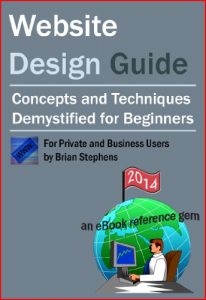Ever wondered how websites are put together? Or whether your present website is working as well for you as it should? In this comprehensive website design guide, Brian Stephens, a website designer and ebook publisher, lifts the lid on the concepts and techniques that can make all the difference to a website's success.
The information demystifies this jargon-riddled business and will help even complete beginners brief web designers and hold them to account if the site is not doing its job properly. For the already computer-savvy, the author leads the way for them to create their own website, either using the Wordpress platform as a content management system or by adopting the most effective techniques for a static website design.
Brian has a 1st class honours degree in Technology, has worked in the technology industry for over 30 years and the last five years as a freelance website designer.
Subjects covered include:
You are also shown how to get traffic to your website by using the most relevant and up to date techniques for website and blog promotion.
These include, on page optimisation as part of the web design, off page optimisation for website promotion and using social signals. Don't worry these terms are fully explained in the guide, but needless to say they cover techniques such as where and how to place keywords in your content, link building and engaging on social media sites like Twitter, Facebook etc.
You will have access to a lot of reference material for the latest web design training resources which explain in detail the techniques, identified in the guide, that need to be used to make a website work.
So no more searching for the best resources and not knowing if you have found them, they can now be accessed directly in the book as and when you need them. Brian made plenty of errors whilst working out the best way to put a website together. Thankfully he is now happy to share his learning experience with you.
The book is ideally suited to anyone who is non-technical and wants to create a simple website for their business or personal use or has had problems getting an existing website organised to meet their requirements.
Existing and future website owners will find this up-to-the-minute guide an excellent point of reference for managing a nowadays powerful business and personal tool. Creating your own website need no longer be the preserve of big business and the most gifted computer technicians. You can have your own website in a matter of days, . . . for a surprisingly low outlay. But read this first! It could save you a fortune, or at least a lot of time.
The information demystifies this jargon-riddled business and will help even complete beginners brief web designers and hold them to account if the site is not doing its job properly. For the already computer-savvy, the author leads the way for them to create their own website, either using the Wordpress platform as a content management system or by adopting the most effective techniques for a static website design.
Website Design - Author Qualifications
Brian has a 1st class honours degree in Technology, has worked in the technology industry for over 30 years and the last five years as a freelance website designer.
Subjects covered include:
- how to choose and register a name for your website
- understanding what you want the website to do both both from a marketing perspective and a functional perspective
- navigation elements and why they are critical
- measuring performance
- who to host with
- how to set a reasonable budget
- how to ensure you can change or add more content to your website, at will, without paying a designer or webmaster
- the benefits of a well designed website
You are also shown how to get traffic to your website by using the most relevant and up to date techniques for website and blog promotion.
Modern Website Promotion Techniques
These include, on page optimisation as part of the web design, off page optimisation for website promotion and using social signals. Don't worry these terms are fully explained in the guide, but needless to say they cover techniques such as where and how to place keywords in your content, link building and engaging on social media sites like Twitter, Facebook etc.
You will have access to a lot of reference material for the latest web design training resources which explain in detail the techniques, identified in the guide, that need to be used to make a website work.
So no more searching for the best resources and not knowing if you have found them, they can now be accessed directly in the book as and when you need them. Brian made plenty of errors whilst working out the best way to put a website together. Thankfully he is now happy to share his learning experience with you.
Who Is This Website Design Guide For?
The book is ideally suited to anyone who is non-technical and wants to create a simple website for their business or personal use or has had problems getting an existing website organised to meet their requirements.
Existing and future website owners will find this up-to-the-minute guide an excellent point of reference for managing a nowadays powerful business and personal tool. Creating your own website need no longer be the preserve of big business and the most gifted computer technicians. You can have your own website in a matter of days, . . . for a surprisingly low outlay. But read this first! It could save you a fortune, or at least a lot of time.






